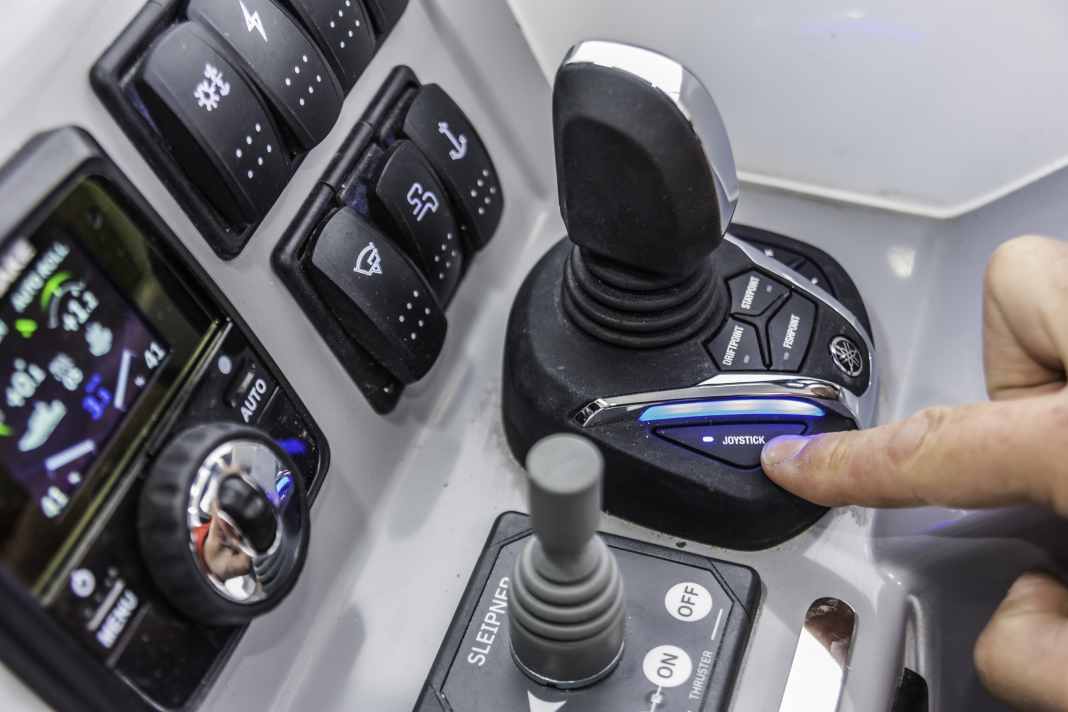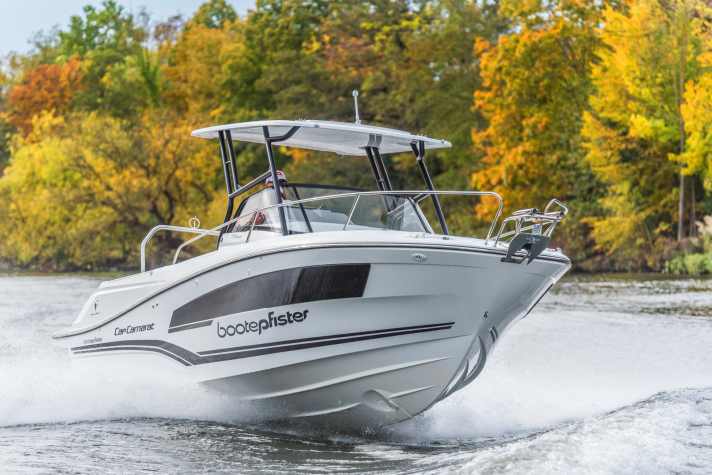Test: Child's play manoeuvring - joystick control with just one outboard motor
Dieter Wanke
· 01.05.2024






Yamaha presented a joystick control system for single outboards in 2022 and Mercury followed suit at the start of the 2024 season. Yamaha's system is suitable for certain models from the F150 upwards, while Mercury's system is only suitable for engines from the 250 V8 upwards. We had the opportunity to test the Yamaha system in a Jeanneau Cap Camarat 7.5 WA with a Yamaha F250. Precise manoeuvring with the boat can be stressful under certain conditions, and not just for skippers with little experience. Mooring in confined conditions quickly becomes a challenge when currents and wind are added to the mix. Joystick steering makes the helmsman's job much easier and damage can be avoided, which puts the additional costs into perspective. Movements on the joystick are converted directly into movements of the boat and the skipper does not have to think about the direction of rotation of propellers, wheel effects, rudder position and other factors. Until now, however, such systems have only worked if at least two vectors, i.e. pulses from two different positions, are available for electronic control, which is why two drives are a prerequisite. Now it should also work with one motor? In principle, yes, but with restrictions.
Basic system from Yamaha in the test
The test boat is fitted with the basic system called Yamaha Helm Master EX, which requires electronic steering (DES) and electronically switched outboards (DBW models) with drive-by-wire technology so that both the engine and the steering can be controlled by the electronics.
The game starts with the F150LCA. If you already have this equipment, you can upgrade. Yamaha provides the Rigging Kit P for this purpose, which is available for 14,761 euros. The system includes electronic steering, the Yamaha CL 5 touchscreen display and the autopilot. If you already have an SBW model with built-in steering, i.e. engines from the F250XSB to the XF425XSA, the Rigging Kit P1, for example, which is offered without steering, is less expensive at €10,427. This means that the system is basically functional. However, with restrictions, as the second vector is missing. This then comes into play optionally in the form of a bow thruster. But even here there are hurdles, because only bow thrusters with adjustable speed can be integrated into the system.
As Jeanneau only offers bow thrusters from Vetus without this control, integration into the Yamaha joystick system was not possible in the test boat. The second vector must therefore be controlled manually via the bow thruster control lever. It is therefore more of a joystick light, which only works here through a combination of the electronic steering system with the forward and reverse movement of the electronic engine control. But this also works well and is definitely better than steering completely manually. The Yamaha system also includes the autopilot, which consists of a panel on the console, a course sensor, the GPS and a control unit, which enables the electronic anchor function and automatic course control.
More on the topic:
We start with an attempt to keep the boat on the spot using the electronic anchor function. This results in deviations of one to two metres. This is completely sufficient for waiting in front of locks. Pure sideways movements are of course not possible. If an appropriate bow thruster were installed, this would also be possible. For a mooring manoeuvre, we also steer manually with the bow thruster, which works well straight away. When operating without an integrated bow thruster, the joystick must always be moved slightly forwards or backwards to keep the engine engaged. Nothing happens if you only move it sideways.
Stay on course with the Jeanneau
Next on the list is holding a course in conjunction with the autopilot. This also goes without a hitch. Despite the wind and light current, the boat stays on track. Turning on the spot with the test boat again only works with manual assistance from the bow thruster. Nevertheless, the system offers the advantage that a lot of things are controlled via the joystick and the throttle and steering do not have to be operated separately. Forwards, we manage a full circle with a diameter of 1.5 boat lengths in both directions without the aid of the bow thruster. In reverse, it is only one boat length. The available thrust can also be regulated, and five different thrust levels can be set.
In Thrust Level 1, a speed range between 600 and 900 revolutions is available. This then increases by 100 revolutions at each level, so that up to 1400 revolutions are possible at the highest setting. This allows the available power to be adapted to the wind and current conditions. Overall, we are satisfied with the results. Due to the lack of a second vector, the function is somewhat limited in the basic version, but it still makes manoeuvres easier. If you can combine it with the bow thruster, you should achieve significantly better results despite the single motorisation, which are close to a dual motorisation. The system is not only an improvement for skippers due to the pure joystick functions, but also due to the practical anchor function and the possibility of automatically holding courses.
Technical data of the boat

- Manufacturer: Jeanneau
- Type: Cap Camarat 7.5 WA
- Length: 7,19 m
- Width: 2,52 m
- Depth: 0,49 m
- Weight (o.M): 1480 kg
- Motor: Yamaha F250
- Motor control: Yamaha Helmet Master EX
- Bow thruster: Vetus (not integrated)

